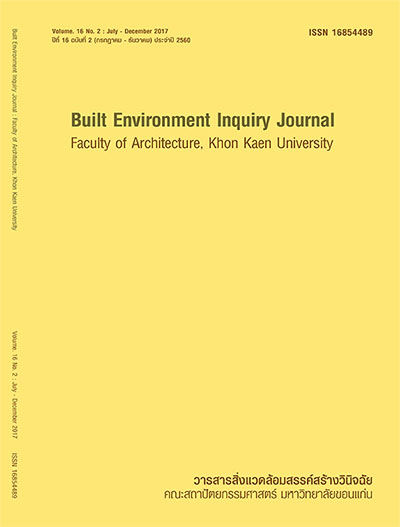การสำรวจคุณภาพสภาพแวดล้อมภายในห้องเรียน กรณีศึกษา: ห้อง 1712 คณะวิทยาศาสตร์ มหาวิทยาลัยศรีนครินทร์วิโรฒ-Classroom Indoor Environmental Quality Survey Case study: Room 1712, Faculty of Sciences, Srinakharinwirot University
คำสำคัญ:
ห้องเรียน, ความสบาย, คุณภาพสภาพแวดล้อมภายในอาคาร, CLASSROOM, COMFORT, IEQบทคัดย่อ
บทคัดย่อ
ศาสตร์ด้านสภาพแวดล้อมอาคารได้ถูกเสนอขึ้นอย่างกว้างขวางจากผู้เชี่ยวชาญเพื่อเป็นแนวทางในการปรับปรุงอาคาร แต่ความรู้ดังกล่าวเป็นภาพรวมไม่สามารถประยุกต์ใช้กับทุกพื้นที่ การประเมินหลังการเข้าใช้อาคารถือเป็นแนวทางที่ทำให้เข้าถึงข้อมูลความสบายและความพึงพอใจของผู้ใช้อาคารได้เป็นอย่างดี ซึ่งเมื่อประกอบกับการวัดและการสังเกต การประเมินนี้จะเป็นวิธีที่สามารถบ่งชี้แนวทางในการออกแบบสถาปัตยกรรมได้ งานวิจัยนี้ประยุกต์ใช้วิธีดังกล่าวในการสำรวจความเห็นของผู้ใช้ห้องเรียน 1712 มหาวิทยาลัยศรีนครินทร์วิโรฒ เน้นศึกษาตัวแปรคุณภาพสภาพแวดล้อมภายในอาคาร ได้แก่ อุณหภูมิ, การมองเห็น, เสียง และคุณภาพอากาศภายในอาคาร เพื่อศึกษาปัญหาและเสนอแนะแนวทางในการปรับปรุงสภาพแวดล้อมภายในห้อง ผลการวิจัยยืนยันว่าความเห็นของผู้ใช้ห้องเรียนสามารถชี้วัดปัญหาของพื้นที่ได้อย่างมีประสิทธิภาพ ลักษณะของห้อง 1712 ยังไม่เหมาะสมต่อการใช้งาน ในแง่ของ ขนาด, ลักษณะช่องเปิด, งานระบบ และการบำรุงรักษา ทั้งนี้ปัญหาดังกล่าวอยู่ในระดับที่สามารถยอมรับได้ มิได้ร้ายแรง ข้อจำกัดที่สำคัญของงานวิจัยนี้คือผลจากการสำรวจสามารถชี้ร่องรอยแนวทางปรับปรุงห้องเรียนเพื่อสภาพแวดล้อมที่ดีเท่านั้น เนื่องจากเป็นเพียงความรู้สึกและความพึงพอใจของผู้ให้ข้อมูล ไม่ใช่การประเมินผลของสภาพแวดล้อมต่อสุขภาพหรือประสิทธิภาพในการเรียน แม้ความเห็นของผู้ใช้อาคารจะมีประโยชน์แต่จะต้องประยุกต์ใช้กับวิธีการอื่นหรือคำแนะนำของผู้เชี่ยวชาญเสมอ
ABSTRACT
While science about how to improve building environment has been widely presented by experts, it can be too generalized to suit every specific space. Post Occupancy Evaluation (POE) is one effective approach for in-depth study of occupants’ comfort and satisfaction. Combined with measurement and observation, it can be used as a guide for architectural design. In this study, the method of POE was applied to survey lecture room no.1712 of Srinakarinwirot University, focusing on some of the Indoor Environmental Quality (IEQ) parameters: thermal, visual, aural and Indoor Air Quality (IAQ) aspects in order to study problems and suggest guidelines for indoor environmental improvement. The results confirm that the opinions of the occupants can effectively identify the problems of the space. The room was found inappropriate in size, apertures, systems and maintenance. The problems are generally acceptable, in other words they are not at a critical level. A significant limitation of this study is that the findings are only implications. Since the survey data are based on the sentiments and satisfaction of the occupants, they can only point the way for improvement of the room, they cannot directly indicate actual effects of IEQ on neither health nor learning performance of the participants. Although the survey data are useful, they should not be used to improve the room without other additional methods or consultation with experts.
Downloads
เผยแพร่แล้ว
How to Cite
ฉบับ
บท
License
ทัศนะและข้อคิดเห็นของบทความที่ปรากฏในวารสารฉบับนี้เป็นของผู้เขียนแต่ละท่าน ไม่ถือว่าเป็นทัศนะและความรับผิดชอบของกองบรรณาธิการ




